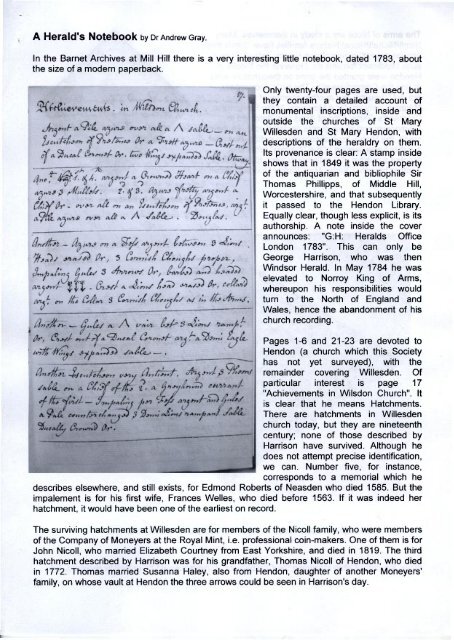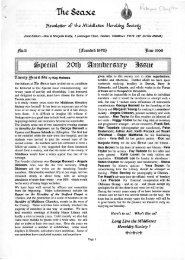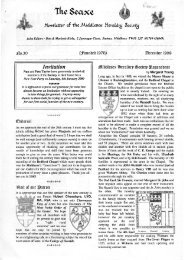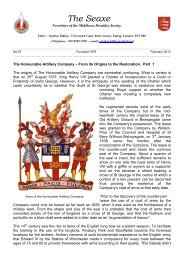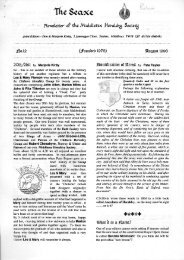The Seaxe - Middlesex Heraldry Society
The Seaxe - Middlesex Heraldry Society
The Seaxe - Middlesex Heraldry Society
You also want an ePaper? Increase the reach of your titles
YUMPU automatically turns print PDFs into web optimized ePapers that Google loves.
A Herald's Notebook by Dr Andrew Gray<br />
In the Barnet Archives at Mill Hill there is a very interesting little notebook, dated 1783, about<br />
the size of a modern paperback.<br />
Only twenty-four pages are used, but<br />
they contain a detailed account of<br />
monumental inscriptions, inside and<br />
outside the churches of St Mary<br />
Willesden and St Mary Hendon, with<br />
descriptions of the heraldry on them.<br />
Its provenance is clear: A stamp inside<br />
shows that in 1849 it was the property<br />
of the antiquarian and bibliophile Sir<br />
Thomas Phillipps, of Middle Hill,<br />
Worcestershire, and that subsequently<br />
it passed to the Hendon Library.<br />
Equally clear, though less explicit, is its<br />
authorship. A note inside the cover<br />
announces: "G:H: Heralds Office<br />
London 1783". This can only be<br />
George Harrison, who was then<br />
Windsor Herald. In May 1784 he was<br />
elevated to Norroy King of Arms,<br />
whereupon his responsibilities would<br />
turn to the North of England and<br />
Wales, hence the abandonment of his<br />
church recording.<br />
Pages 1-6 and 21-23 are devoted to<br />
Hendon (a church which this <strong>Society</strong><br />
has not yet surveyed), with the<br />
remainder covering Willesden. Of<br />
particular interest is page 17<br />
"Achievements in Wilsdon Church". It<br />
is clear that he means Hatchments.<br />
<strong>The</strong>re are hatchments in Willesden<br />
church today, but they are nineteenth<br />
century; none of those described by<br />
Harrison have survived. Although he<br />
does not attempt precise identification,<br />
we can. Number five, for instance,<br />
corresponds to a memorial which he<br />
describes elsewhere, and still exists, for Edmond Roberts of Neasden who died 1585. But the<br />
impalement is for his first wife, Frances Welles, who died before 1563. If it was indeed her<br />
hatchment, it would have been one of the earliest on record.<br />
<strong>The</strong> surviving hatchments at Willesden are for members of the Nicoll family, who were members<br />
of the Company of Moneyers at the Royal Mint, i.e. professional coin-makers. One of them is for<br />
John Nicoll, who married Elizabeth Courtney from East Yorkshire, and died in 1819. <strong>The</strong> third<br />
hatchment described by Harrison was for his grandfather, Thomas Nicoll of Hendon, who died<br />
in 1772. Thomas married Susanna Haley, also from Hendon, daughter of another Moneyers'<br />
family, on whose vault at Hendon the three arrows could be seen in Harrison's day.


